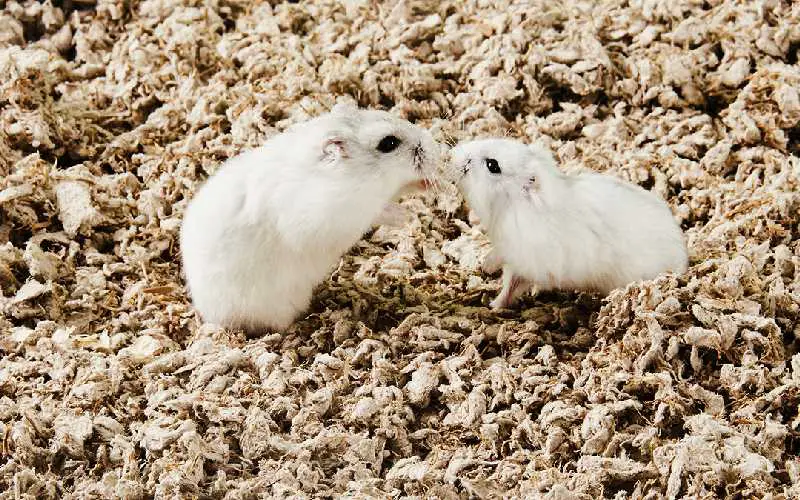hamsterhappy.co.uk is a participant in the Amazon Services LLC Associates Program and other affiliate advertising programs designed to provide a means for us to earn fees by linking to Amazon.com and affiliated sites. Affiliate links may be used on this page and in hamsterhappy.co.uk articles, but they do not impact on the price that you pay and they do help me to get this information to you for free. Read my privacy policy for more information regarding affiliates.
Our post is about dwarf hamster breeding. Prevention of a female hamster going into heat includes making sure they are well fed and that there is sufficient nest box space for them to create a nice, large nest so that they have somewhere cozy to stay when females go into estrus.
A change in routine can also be helpful. A sudden change in environment, temperature, or both might be enough to disrupt the cycle of estrous phases in the female. You could try adding some new objects (e.g., flowers) to their habitat, tucking some fresh hay among their old bedding or even just moving the cage around your house every day or two for a few days at a time.
It is not known whether there is any truth to the claims that female hamsters who are in poor health or going through stressful episodes tend to go into estrus more often than otherwise. But it does seem to make sense that a female hamster who is in good general health, well-fed and not under undue stress or subject to harsh weather conditions would not enter estrus as frequently.
The gestation period for dwarf hamsters is 16–18 days. The pups usually arrive on day 18 of their development, though one can come sooner—or later—than the “average” time period. Usually the mother gives birth around 10:00 pm–midnight. The female hamster usually is ready to breed again about three weeks after the birth of her last litter, but in some instances it is more like four weeks.
Sometimes this isn’t possible—for example, if the nest box has become occupied by another mother and her pups. Occasionally babies are removed from a nest they don’t have enough space for because their mother has gone into estrus and created a larger nest. So if you have a female who went back into heat and had babies more quickly than the average for your hamsters, it may be that she’s not pregnant but was able to go back into heat sooner than usual because she gave birth to pups who could fit into a smaller nest box.
This is not always the case with dwarf hamsters, but it is common for dwarf hamsters in captivity to only have two or three pups in a litter. Hamster females generally give birth to about five pups at a time, but it can up to 10 or even 15!
We have also been asked why dwarf hamster babies are so small at birth. Some species of hamsters give birth 22 days after fertilization. But others produce young only 19 days after fertilization (the same length of time as the gestation period for some other rodent species, such as voles).
Males, on the other hand, mature quickly—they are sexually mature as early as eight weeks after being born. But hamster males don’t usually have the opportunity to reproduce until they are two months old, because their female counterparts don’t usually reach sexual maturity until they are around four weeks old.
Once a dwarf hamster reaches sexual maturity in captivity, he or she is capable of breeding anytime from January to August. But it is common for them to have one or more “false pregnancies”; i.e., they may act as if they’re pregnant when they’re not actually carrying any pups but instead just making a nest in preparation for a litter that never happens (this is generally referred to as pseudopregnancy).
The average gestation period for a dwarf hamster is 16–18 days. A mother usually gives birth to four to eight pups, but sometimes there can be as many as 14 or 15. The father is generally the last of the litter to be born, and so he tends to have the least fuzzy fur.
Baby dwarf hamsters are born with their eyes closed, and their ears barely open. They’re completely helpless at birth, so it’s important that they receive lots of maternal love and care. The mother should stay with her pups in her nest box until they’re about two weeks old.
The mother will leave her pups for short periods in order to obtain food, but she’ll be back soon. The baby hamsters weigh about 0.045 ounces (1.2 g), and are about 1.25″ (32 mm) long when they’re born.
As the babies age, their eyes open after five days, and their ears begin to stand up straight after seven days—but they won’t be able to move around on their own for another three or four days, as their underdeveloped legs make it difficult for them to move around. Pups’ blind period ends at eight days. At this time, their eyes are fully open. At about 10 days old, they start to develop fur—this process lasts until about 16 days of age.
At two weeks, the small hamsters will begin to leave the nest box. They will venture out into their wire cage, but usually stay fairly close to the safety of their box and keep a watchful eye on their mother while looking for a nipple to drink from or a teat to suck on. This is why it’s essential that the cage includes more than one nest box for them (ideally at least four).
If you enjoyed this article you might also like to read about Dwarf Hamster Breeds.


